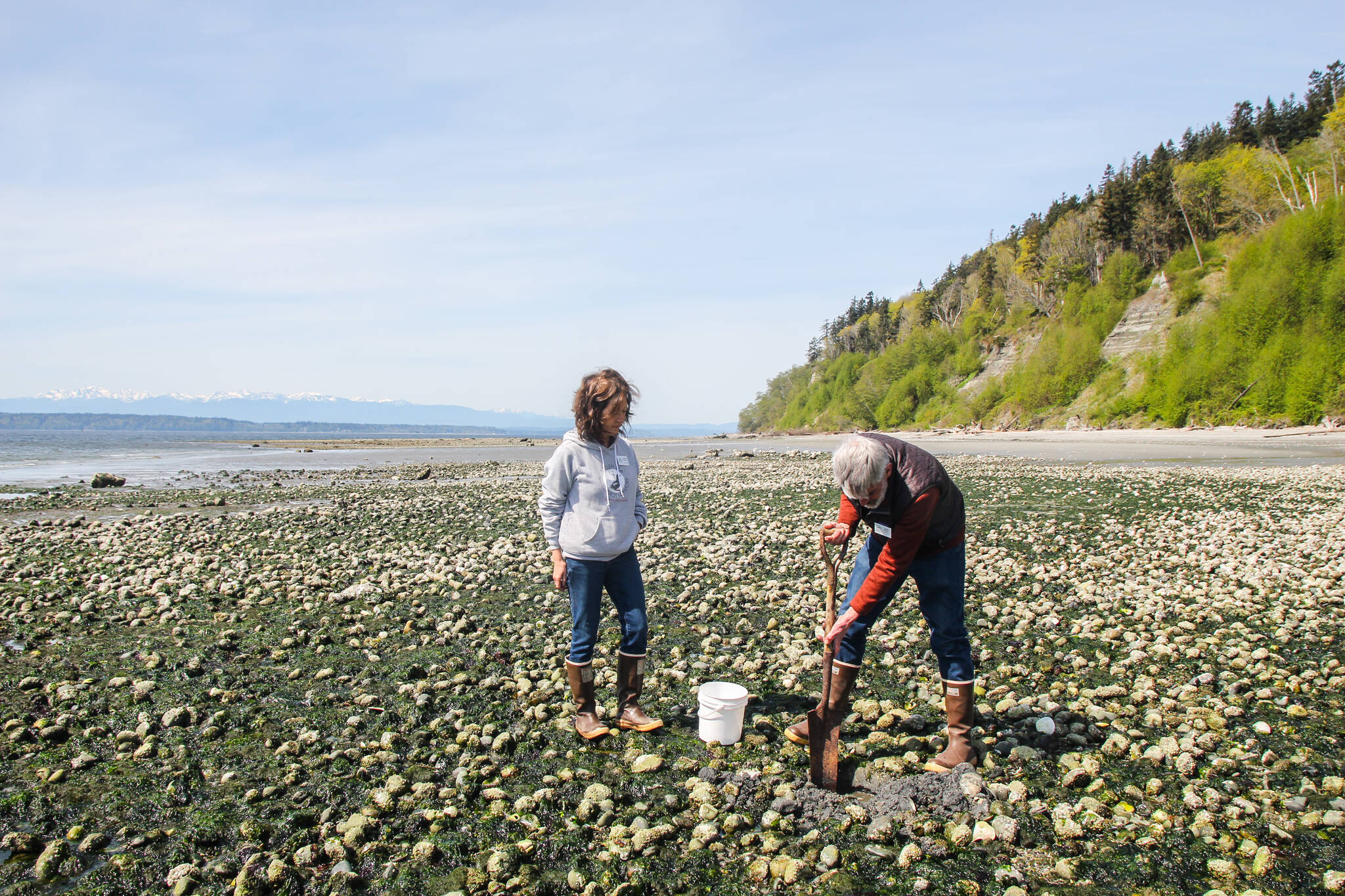As Whidbey’s shores continue to be closed to the harvesting of butter and varnish clams, scientists are still scratching their heads over the causes leading to the production of paralytic shellfish poison.
In the meantime, agencies like the Washington State Department of Health have been relying on citizen scientists to help solve this puzzle. Among them are Leigh Bloom and Michele Sakaguchi, two Clinton residents and Sound Water Stewards grads who have been digging for answers to support the department’s marine biotoxin monitoring program.
Monday afternoon, the couple walked on a private beach in the Scatchet Head neighborhood, scanning the landscape for water squirts erupting from the rocky intertidal zone. Armed with a shovel and a bucket, Bloom walked to the point of origin of the little fountains, hoping to find butter clams to send to the Department of Health’s lab in Shoreline.
The beach is one of the locations on the island where citizen scientists have been specifically looking for butter clams. There, Bloom and Sakaguchi have been tasked with finding 12 live specimens every two weeks, Bloom said.
When the Department of Health reached out to the nonprofit for support in this endeavor last summer, he said, the goal was to take samples once per month. This schedule, however, changed due to growing concerns over the rising levels of paralytic shellfish poison, which Marine Biotoxin Specialist Tracie Barry said exceeded 1,000 micrograms per 100 grams of tissue in August.
Barry, who works for the department, said the Whidbey basin has been experiencing a resurgence in paralytic shellfish poison in recent years after a period of “quiet.”
Here, scientists observed high levels between the late 1970s and mid 1980s, with the highest levels ever found in the state recorded in Holmes Harbor in 1978, Barry said. While the unsafe level for human consumption is set at 80 micrograms per 100 grams of mollusk tissue, the Holmes Harbor samples showed staggering levels exceeding 30,000 micrograms per 100 grams, she said.
For unknown reasons, the biotoxin made a comeback in 2017, resulting from blooms starting earlier and lasting longer over recent years, Barry said.
To make matters even worse for butter clam fans, these mollusks retain biotoxins for longer than other clams. In 2022, for example, someone got paralytic shellfish poisoning despite the bloom occurring a year before, she said.
“Those species hold on to paralytic toxins (for) years after a bloom is over,” she said. “It can lead to illnesses simply because people are tired of those closures, which is unfortunate.”
As the name suggests, this biotoxin can paralyze the muscles of those who consume it and, in the worst cases, result in death. It’s produced by a group of “bad” phytoplankton known as “Alexandrium,” Barry said.
By collecting data and informing beach closures, Bloom said, volunteers are helping save lives, though he said people should be more conscientious and look up what beaches are closed and what species are unsafe to eat.
According to the Department of Health, death from paralytic shellfish poisoning can occur in less than 30 minutes.
The Department of Health is also monitoring the presence of amnesic shellfish poisoning and the diarrhetic shellfish poisoning toxins, though they did not exceed safety levels when detected, Barry said.
While scientists don’t yet have a grasp on what exactly is making the Alexandrium algae thrive and produce large amounts of paralyzing toxins, the resulting blooms seem to be naturally occurring, particularly in the summer, and not necessarily related to water quality. According to Barry, deaths from paralytic shellfish disease have been documented as far back as 1793.
With artificial intelligence becoming more advanced, Barry hopes this technology will help researchers find out what is going on. For now, part of the answer seems to be hidden in what she called the “shellfish smoothie.”
After harvesting enough clams, Bloom and Sakaguchi rinse them off, bag them up with some ice and send them off to Shoreline, where the clams are shucked and blended into an unappetizing gray puree — the “smoothie” — to be analyzed.
This is the only way to assess whether mollusks are safe to eat, Barry said.
“You cannot tell if shellfish are safe by the color of the water,” she said. “Most toxic blooms aren’t visible at all.”
Once it serves its purpose, this potentially lethal shake is either incinerated or saved to compare with other samples, Barry said.
Results are typically released after a few days, Bloom said. The Scatchet Head samples collected two weeks ago showed that levels had gone down since the previous sampling, though they were still “barely above the threshold at which they would keep the beach closed,” he said.
Laboring against the backdrop of the Salish Sea, the Olympic Mountains and Mount Rainier, Sakaguchi and Bloom were happy to be of help, despite finding more empty shells than live clams in what Sakaguchi said was an unusually slow day.
With limited funds and time, scientists appreciate the hand, she said. As a science teacher at Woodhaven High School, she would like to see more youths join the effort.
Barry has been particularly appreciative of the help, learning techniques from volunteers who often recruit their own friends, family and neighbors to help keep the community safe and informed.
“It’s just an incredible network and everyone is so excited to support safe shellfishing,” she said.
To stay up to date with beach closures, visit the Washington Shellfish Safety Map at fortress.wa.gov/doh/biotoxin/biotoxin.html. To learn more about Sound Water Stewards and their efforts on Whidbey and Camano, visit soundwaterstewards.org.


